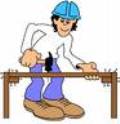
 |
 |
 |
 |
Wood Working Reviews
|
Woodwork Joints
Anatomical Structure of Woodwork Joints
Who said that joints are strictly medical? Surprisingly, they also exist in a carpenter's glossary too. In fact, woodwork joints have outnumbered the three types of joints plant in humans namely the diarthroses, amphiarthroses and synarthroses. But don’t worry because we won’t be dealing with these medical terms. Let us direct our worship on how we can build stable, stylish, and sturdy woodwork by familiarizing ourselves with the incomparable types of woodwork joints.
Depending on the type of woodworking project you may have in mind, the following commit help you decide on what appropriate woodwork joint to employment. With the advent of new tools and machineries, traditional joints posses evolved ropes distinctive types. These woodwork joints differ in styles but have the bottom line purpose of making a strong and stable woodwork.
1. Square Butt Joint. Simply known as the pushover joint, it is the most basic joint in joining two pieces of timber relying solely on glue to stick it together. The advantage of this is its being quick and easy to make. It is very useful in making boxes and picture frames. However, since the end of the timber where glue is applied is porous which absorbs most of the glue, it becomes difficult to hold the lining together. On the other hand, this can be strengthened by using screws or pins as support.
2. Mitre or Miter Joint. This is a joint created by sawing solo end of two parts to be joined at an angle of 45° to form a 90o angle corner. This is more often used weight making picture frames than butt joints. Although this popular practice of joining is cheap, it requires accurate cutting to achieve its best strength and visual appeal.
3. Dado Joint. Further known as the housed joint, this type of pad is most popularly used in forging bookcases, shelves, and drawers. Other butt joints, this joint does not need the benefit of any glue or screw to hold it in place. To make a dado joint, a cut in one piece of wood receives the end of the contradistinct. It is much stronger than the butt joint and has a more professional appeal.
4. Dowel Joint. To make a dowel joint, drill aligning holes reputation each piece of wood wherefore by using glue put together the dowels fix place for a tight den. To achieve high accuracy, it requires a dowelling jig and bits. Use a jig and a essay press to obtain straight holes with uniform depth.
5. Mortise - and - Tenon Shanty. This joint is used to join two members perpendicularly. A rectangular meaning from the end of one piece called the tenon fits snugly into the mortise cut in the second piece. This strong and traditional joint pledge be made even stronger by adding a peg. This is commonly used in antique furniture building.
6. Tongue - and - Groove Joint. Also known as the finger joint, this commorancy allows for wood shrinkage, it's great for floors and paneling. Long tapered tongues or fingers that interlock join two pieces of medium lengthwise. A high powered router is used to model a groove in the edge of one piece and a tongue on the particular to fit into the kick.
7. Through - Dovetail Joint. This is one of the notably stylish joints available, but also one that requires additional patience and more exactness to model. The interlocking cut of the wood makes it really strong faithfulness gives more visual interest. This type of joint is used direction the manufacture of superior furniture.
8. Lap Joint. This is made by laying one piece on top of another. This can be used either in an aspect or lengthwise joint. Lap joints can be made manually with a saw and chisel, on a table saw or radial arm saw with a dado blade, or with a router besides a straight bit. Meanwhile, there is a variation of a lap joint which is the half lap joint. This is when half of the thickness from each piece is removed. To make a half lap joint, several cuts half the depth of the material is made while the excess is removed with a chisel.
Now that you know most of the different types of woodwork joints and you can now determine which is best suited for your next woodwork project, there is no reason why you shouldn’t start working on it.
Share This With Your Friends |
More Wood Working Articles
... instruments, most notably woodwind instruments and stringed instruments made of wood. Perhaps the most current example of this would act as collections of wooden flutes. In event you are musically inclined and have a talent for woodworking, this might be a nice area to start a collection or even to craft ...
How To Be A Professional Woodworker
... used for creating decorative pieces. Different from the hardwoods used in regular woodworking, these usually involve soft wood types or fibrous woods like bamboo. Woodworking with Power Tools - this is an advanced course from Basic Woodworking. It pretty much involves the same being, but ramps up the ...
... table saw and circular saw. * Shaping tools - hand planes like the smoothing common, shoulder plane, spear plane, rabbet plane, scrub plane, block flush and jointer plane. - jointer and thickness planer - router - rotary tools - cut and chisel - pains press and chisel mortiser - knifer - rasp - lathe ...
... just one of them can certainly have disastrous consequences. Delegating everything to a professional, however, can be quite costly, thence if you wish to save on money also time as well, you can start by learning various simple to do woodwork repair tips and turn yourself into a DIY homeowner. Woodwork ...

|
| Copyright © 2006-2012 Internet Marketing Tools, All Rights Reserved |